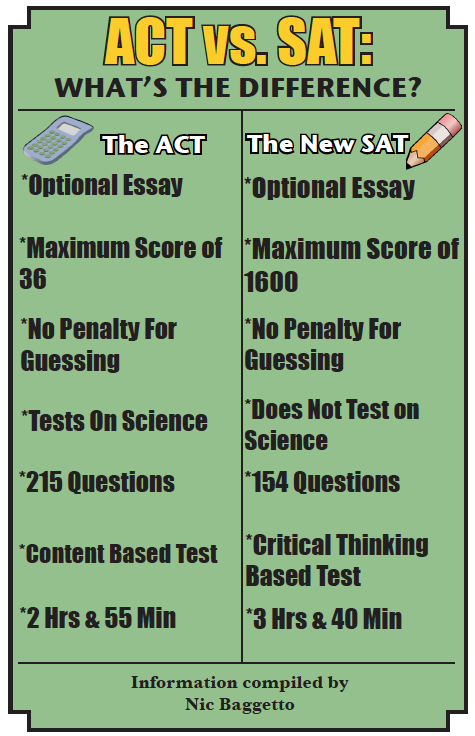Statewide ACT test ousted in recent contract shuffle
February 19, 2016
Starting next year, students will no longer be taking the ACT on the Illinois government’s dime; instead, students will be taking the SAT.
This year’s juniors, however, are still taking the ACT, provided by the district. The change was a matter of contracts with the state, according to Megan Knight, Associate Principal for Instruction.
“The state of Illinois’ contract with the ACT was up, so the state… put out an RFP (request for proposals) earlier this [school] year for a new college entrance exam,” Knight said. “Obviously, SAT and ACT are the two competitors in that field, so we knew it was going to be one or the other.”
Nonetheless, the change is aggravating teachers and division heads alike.
“I would’ve liked to see them still go with the ACT because it’s the most widely accepted, especially in the midwest,” math teacher and former ACT prep class teacher Persida Bujdei said.
“A lot of kids will still have to take the ACT,” Bujdei said. “That’s unfortunate because it basically takes away the opportunity from a lot of kids, especially those who would not be able to afford it, to take the ACT.”
In addition, the tests vary in basic ways from each other.
According to Social Science Division Head Tim Phillips, the SAT combines English and reading into one section, whereas English and reading are tested in separate sections on the ACT.
The breadth of topics is also a key difference. “The SAT does go into some topics that the ACT didn’t,” Bujdei said. “Essentially, you’re scratching the surface of a lot of different topics rather than going into some depth.”
The question types in math, at least for now, also apply skills in contrasting manners.
“SAT math is a little bit more rote,” Bujdei said. “ACT types of problems make you think a little bit more.”
However, the SAT is undergoing significant changes starting with the March 5 test. According to Math Division Head Chris Rugg, the “redesigning” will make the SAT “more similar to what the current ACT looks like.”
Earlier this year, the junior class was confused as to whether they were going to take the SAT or the ACT this spring. “[For] the last two years, the predominant work done to prepare the current juniors for their state testing centered around the ACT,” Rugg said.
To offset the confusion, and to get around the budget deadlock in Springfield that is preventing a statewide test from being given, the district decided to provide an ACT on April 19 for the juniors. Phillips said the district “wanted to make sure there was a test provided for all students.”
Although the state is changing to the SAT, the school is still considering continuing to offer ACT prep classes. “Kids are familiar with the ACT. There’s a certain comfort level, so kids want to take it,” Bujdei said. “If kids continue to take the ACT in addition to the state-provided SAT, then we still want to prepare them for that.”
Many students may be concerned with whether college admissions will affect those taking the SAT. According to Phillips, both the ACT and SAT are “accepted universally.” Also, the impact of the SAT on college admissions for those who perform poorly on it due to little preparation should not worry students, as the test is just “one measurement colleges use to get into their program,” English and Fine Arts Division Head Wendy Relich said.
There should not be much of a issue with taking the SAT or the ACT, because “either test will be an acceptable measure to help students get into college,” Rugg said.
Students are able to take each test multiple times which can increase their performance. “Research shows the more often you take the test, the better you do,” Rugg said.
Even with the hoopla over testing, the concerns are much broader in the long term.
“What we should be doing as teachers is preparing kids for what they’re going to need down the line,” Bujdei said. “We might still see a little bit of preparation for both [tests.]”
The change has already sparked moves on the part of the administration.
“What we’re really doing right now… is looking at our existing curriculum and… the SAT versus the ACT, and how it could or could not impact the curriculum that we currently instruct,” Knight said.
The changes may not be as significant as they seem. “The reality is, if you look at the ACT college readiness standards in comparison to the standards set forth by the SAT, while the language may look different, there are many, many similarities,” Knight said.
Even so, it is still a significant adjustment, because “teachers spent many years focusing on the ACT, [and] now it is the SAT,” Phillips said.
Relich assured that there will be “no change in courses” for students, and that they will be “taught the language of the SAT.”
The current challenge for students and teachers comes in learning more about the SAT, because “there [is] a lot of crossover and differences,” Phillips said.
Next year, the SAT will be taught in student curriculum. There will be SAT practice tests similar to the current ACT practice tests.
“We’re confident that our students are still going to be getting what they need academically to be successful moving forward,” Knight said. “We’re trying to minimize the impact on students as greatly as we possibly can.”
The future is more uncertain.
“The experience [for students] will be fine, but ultimately, they’re going to have to add to that experience in taking the ACT,” Bujdei said. “Ten years from now, who knows?”
However, at least in the short-term, the student curriculum will not change too much. “As a student, you should not feel significant change,” Rugg said.






